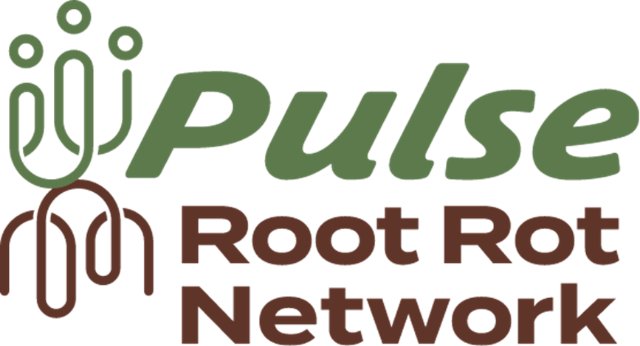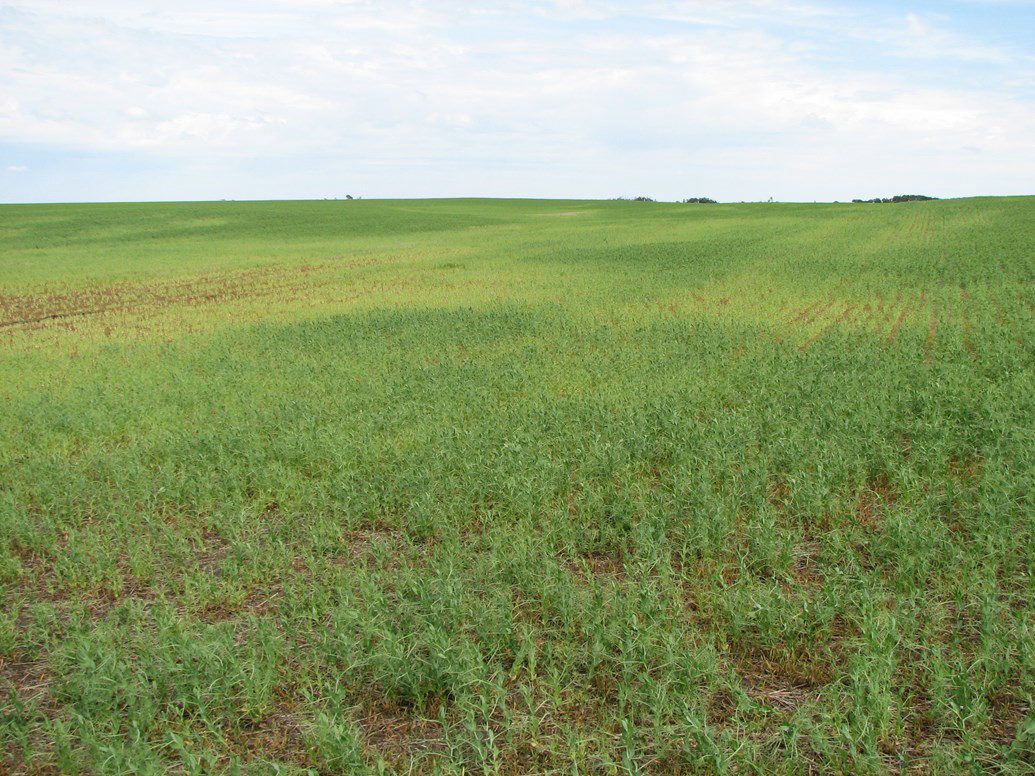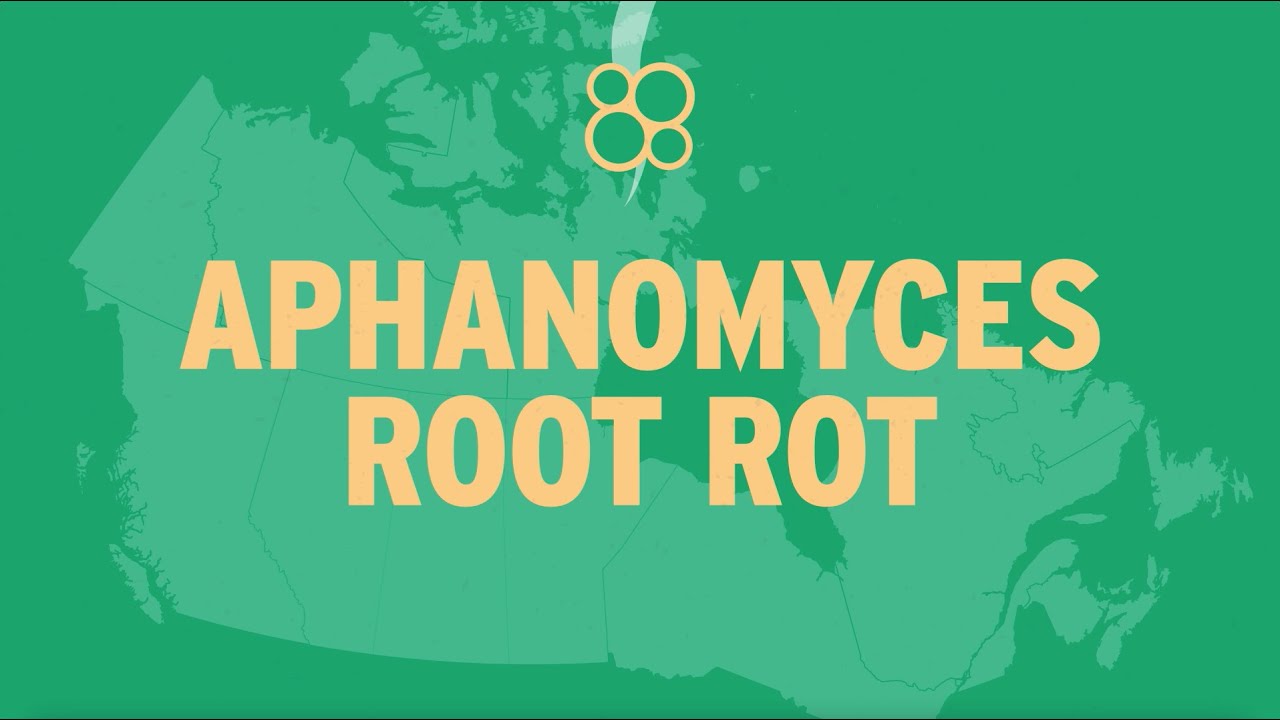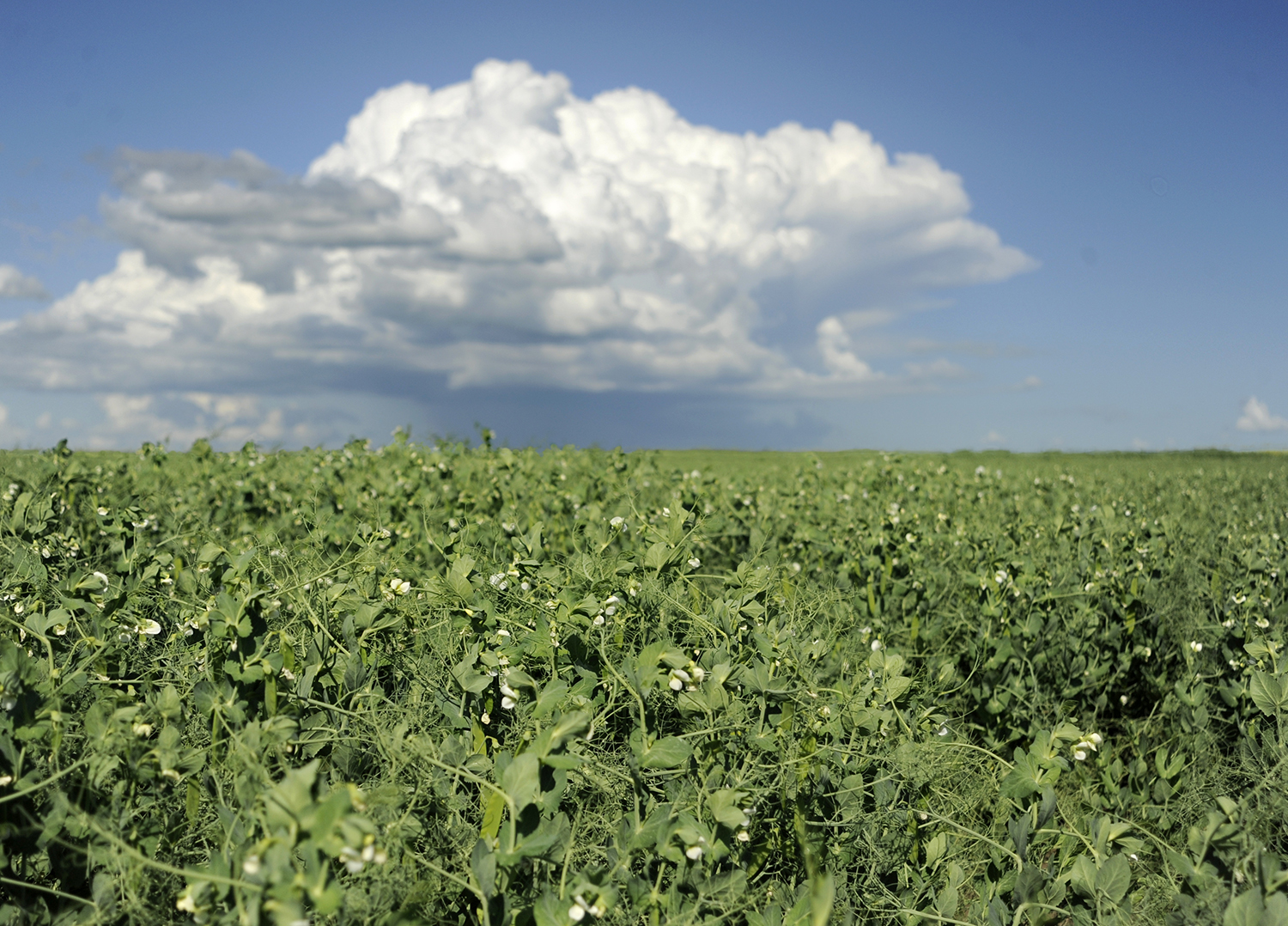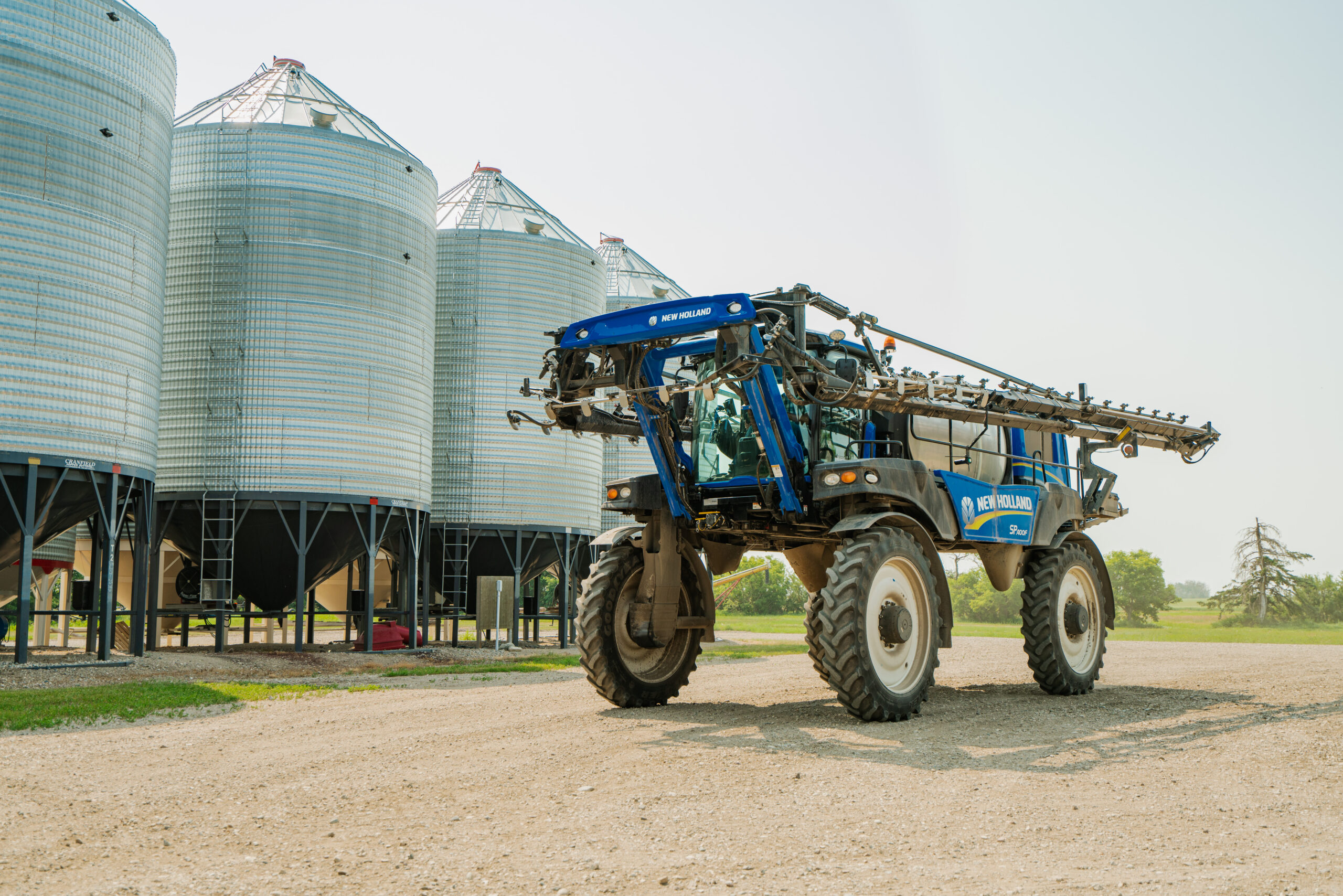Root rots continue to plague pea and lentil crops in Western Canada. Understanding management strategies to reduce the risk of infection in future years starts with identifying the issues in existing fields and tracking over time. After we know what we are dealing with in a field it is all about planning to reduce the spore load. For future pea and lentil crops it is about proper risk evaluation and reducing the risk of infection through field choice, field histories, rotations, and management decisions.
Setting a Baseline on Fields Already Infected with Aphanomyces
Fall soil sampling can be a great time to establish a baseline not only for soil fertility but also pathogen load. With root rots it is the level of Aphanomyces euteiches in the soil that sets the risk for future pea and lentil crops. Knowing what areas of the field were most affected is important as it usually starts increasing in severity in compacted areas (field entrances or headlands), low lying areas, and side hill seeps, and then eventually spore loads build under the right conditions to infect the whole field. Soil samples are a good way to document the Aphanomyces oospore levels at one point in time. You can either take a representative sample from across the field if the whole field is infected or take it from high risk areas. Make sure to mark the areas sampled so you can go back over time and resample to ensure your results are from similar spots and to see if levels are changing. Collect soil samples from a 4-8 inch depth after the thatch or residue layer is removed. Remember the soil contains living organisms so it is important to handle it properly, keeping it cool and out of direct sunlight, and deliver to a lab as soon as possible. Refer to the Testing for Aphanomyces document for the list of soil testing labs and the specific tests offered. If you are looking at establishing a baseline you will want to go with a lab that can accurately quantify the number of oospores per gram of soil, as opposed to just reporting if Aphanomyces is present or not.
Reducing Risk of Infection in Upcoming Pea and/or Lentil Fields
1. Soil Sampling Fields Prior to Planting to Peas or Lentils
It is important to sample fields prior to planting peas and lentils to understand whether Aphanomyces is present and at what levels. There are DNA tests that provide data on either the presence or a quantification of oospores based on extraction from soil. A challenge with these tests is getting a representative sample of an entire field into 1 gram (g) of soil and then getting the oospores out of the soil and breaking open their thick cell walls to extract the DNA. Researchers are looking at ways to improve the test procedures and increase the consistency and reproducibility of the tests, especially under dry soil conditions where false negative rates can be high.
There is also a bait test where peas are actually planted into the soil and then the pea roots are analyzed for infection by Aphanomyces. The bait test is very sensitive as the peas growing in the pot will attract the zoospores released from germinating oospores. The bait test also uses a larger sample of soil compared to the DNA extraction tests which rely on very small (0.5-1 g) amounts of soil to represent the entire field. Bait tests in combination with DNA tests are the most accurate for determining the presence and infectivity of Aphanomyces.
For predicting risk going into the upcoming season it is about the presence or absence of the pathogen. Most labs have a threshold level of detection and above that level the field is considered high risk. Some labs report as positive or negative; risk as low, medium, high; or provide actual quantitative numbers. The accuracy of the test is only as good as the sampling procedures and can be severely impacted by variability in the field. Due to the small amount of soil analyzed (<1 gram) there is a chance that Aphanomyces oospores may not be present in that sample or at very low levels, even if Aphanomyces is present in other areas of the soil. This means there is a chance of having false negative results. If negative results are obtained it does not guarantee the absence of Aphanomyces, it could mean that in the small sample size the level of DNA was below a detectable level or there were issues with the extraction of the DNA as mentioned previously. There is a lot of variability in a field and within soil so relying solely on soil sample results is not recommended.
2. Review Past Field History
a) Number of times peas/lentils have been grown in a field
It is important to know how many times peas or lentils have been grown on a field as the higher the frequency, the greater the risk for build-up of soil-borne pathogens. It has been suggested that it only takes growing susceptible crops five times to increase soil pathogen levels under the right conditions. In Saskatchewan and Western Canada peas and lentils have been grown for approximately 20-30 years on most farms. With a four-year rotation this means peas or lentils have been on these fields 5-7 times. With shorter rotations such as lentils in a two-year (lentil-durum) sequence these fields would have had lentils 10 times in the past 20 years. This means that many acres in Saskatchewan that have been long time pea and/or lentil fields are at the most risk. Going forward, avoid fields that are long-time pea or lentil fields by choosing fields that are relatively new to growing pulses or have been out of pulses to reduce the risk.
b) Environment when peas/lentils were previously grown
It is not only the number of times the susceptible crops have been grown but how many of those years were conducive to Aphanomyces infection. Aphanomyces likes water and disease infection is always worse in wetter years, particularly when May/June have higher than normal precipitation.
For example, in 2020 there were a number of lentil fields that were devastated by root rots in west central Saskatchewan. Many of these fields were last planted to peas or lentils in 2016, four years previously. In that area, 2016 was a wet year which meant a higher risk for infection and likely large increases in the Aphanomyces oospore load in those fields during that year. In the years since, even in drier than normal growing conditions, one or two timely rains have resulted in heavy root rot infestation which continues to be linked to fields that had peas or lentils during the wet 2016 growing season. Looking at the environment the last time or last few times peas and/or lentils were grown is important to determine if the field could be at higher risk for future years.
In general, Saskatchewan experienced above-average rainfall early in the season in 2010, 2012, 2014, and 2016 (for historic climate conditions see Agriculture and Agrifood Canada). Avoiding fields that had peas or lentils in those years will help reduce the risk of severe infection by Aphanomyces. For example, a tight two-year lentil rotation in 2020 in southwest Saskatchewan would have had lentils in 2010, 2012, 2014, 2016, and 2018 of which four out of five years were above average for early season precipitation. In this example, the two-year rotation on lentils has a high risk of developing root rot infection due to inoculum load build-up from intensified rotations in previous seasons that experienced above-average rainfall. Growers who practice a three-year rotation on lentils may be better situated to grow lentils in any given year, as the there is a greater chance last time their fields had an aphanomyces host crop was not under high moisture conditions and the frequency of the host crop in rotation is significantly less. However, it is highly recommended that growers considering growing lentils or peas in any given year examine their past rotation as a whole and consider testing their fields for aphanomyces oospore loads utilizing soil bait tests in the fall to establish the risk potential on a field by field basis. Figure 1 provides a visual example of a field of peas grown on a half section that was combined from two quarter sections into a half section field in 2014. On the left side peas were grown in a 4-year rotation with peas grown in 2006, 2010 and again when this image was taken in 2014. On the right, peas were grown in an 8-year rotation; peas in 2006, canola in 2010, and peas in 2014. One additional year of pulses during a high moisture year (2010) led to heavy oospore load and subsequent disease pressure on the left side of the field.
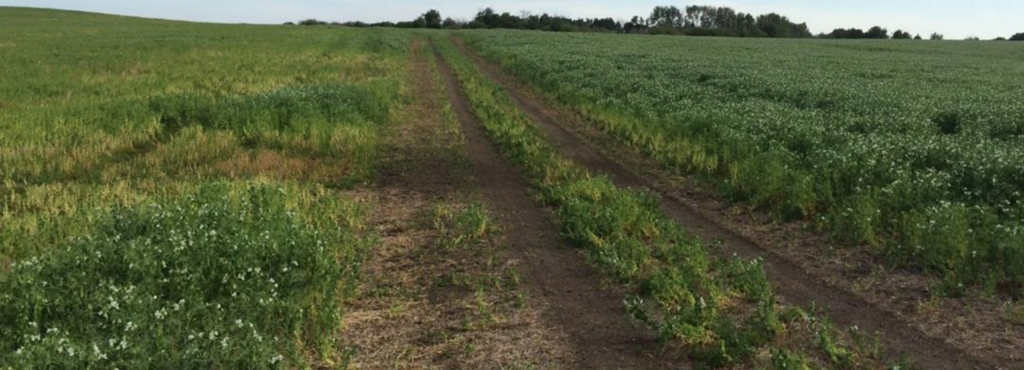
3. Rotation
For whole fields that are infected it is recommended to move away from peas or lentils for 8-10 years to allow time for the spore loads to decrease below threshold levels. It is not so much about the exact years between susceptible crops but what the severity was in the past, the environment during the years the crops were grown, and what has been on the field since.
Aphanomyces has very long-lived resting spores that remain viable for 10+ years. That means the degradation of the oospores occurs very slowly over time. In fact, 10 years may not be enough under very high levels of infection and many areas of the world have abandoned some fields for pea production as a result of this.
Reducing the spore load in the soil for Aphanomyces has been challenging. Research looking at incorporating green manures from oats, corn, rapeseed, and mustard has shown some positive impact on the severity of disease under greenhouse conditions, and a research project by Dr. Syama Chatterton with Agriculture and Agri- Food Canada, Lethbridge, has just recently started to evaluate green manure and grain crop impacts on spore load in Western Canada. Dr. Chatterton and her team are investigating oats, rye, mustard, forage mixes, and non-host legumes but field trial results are not yet available.
4. Choosing the Right Field – Texture and Drainage
Field choice can influence the risk of Aphanomyces as it is all about water management. Fields with heavier textured soils (high clay content) and poor drainage are most susceptible to water logging or holding onto water and are therefore more risky. Aphanomyces needs free water to move to the roots and infect the crop. Choosing fields that are drier, lighter in soil texture, and have good drainage can help reduce the risk of Aphanomyces. Soil compaction can also impact the soil’s ability to drain and therefore managing compaction or avoiding fields with compaction is also a good strategy to reduce risk.
5. Choosing the Right Field – Managing Fusarium
The root rot complex consists of more than just Aphanomyces and we know the most severe fields are usually infected with more than one pathogen. In fact, it is usually Aphanomyces and Fusarium together that are the most devastating. Therefore, it is not only about managing Aphanomyces but Fusarium as well. Fusarium is a common pathogen to all crops grown in Western Canada and can cause roots rots as well as Fusarium Head Blight (FHB). One suggestion for managing root rots in peas and lentils is to avoid fields that were heavily infected with FHB and where there is a lot of infected residue remaining in the field. The heavily infected residue could add to the Fusarium loads in the soil and increase the risk of Fusarium root rots. In the presence of Aphanomyces these fields could then be severely impacted by root rot. Therefore, reduce risks by choosing fields that are free from or have low levels of Fusarium-infected residue.
6. Crop Class and Variety Selection
Peas and lentils are equally susceptible to infection by A. euteiches and a lot of work is going into developing new varieties that confer some resistance, but it will be some time before they are available commercially. Fusarium is also important to consider. Recent work by Dr. Sabine Banniza with University of Saskatchewan has shown that there are some differences in varieties and classes of peas and lentils for resistance to Fusarium avenaceum under controlled conditions (Fusarium Root Rot in Pulse Crops). If variety choice can influence the tolerance to Fusarium, the thought is that it may help reduce the overall severity of root rots when combined with Aphanomyces infection. Crop types with tannins in the seed coat (ex. maple peas) do provide some protection to Fusarium infection and other pathogens that may try to infect the seed when the pathogen is seed borne. More recent work by Dr. Chatterton has shown that the tannins help reduce seed infection but do not provide season-long resistance.
The species of Fusarium that is present can also influence the severity of infection. Dr. Chatterton has found that peas are susceptible to the aggressive nature of both Fusarium solani f.sp. pisi and F. avenaceum. With lentils there is more tolerance to F. solani than peas and green lentils appear to be more tolerant than reds to F. avenaceum. Therefore, lentils and peas do differ to some degree in tolerance to Fusarium species which may affect the severity of root rots when combined with Aphanomyces infection. Consider growing varieties of peas or lentils with tannin in the seed coat and/or varieties with more tolerance to Fusarium species to help reduce the risk of early infection or severity of root rot infections.
7. Seed Quality and Insect Pressure
Seed quality is important and sourcing seed that has good germination, vigour, and is disease-free can help to reduce the introduction of pathogens into fields. Fusarium can be seed-borne but to date no Aphanomyces has been detected on seed. Managing introduction of Fusarium is important for managing root rots. If Fusarium is present on the seed, a seed treatment is important to help manage it.
Seed treatments are available for control of Fusarium and early season suppression of Aphanomyces. These seed treatments will not protect high risk fields or fields with known infection by Aphanomyces. For fields that are lower risk seed treatments can help to keep infection levels down and should be considered. Another consideration is nodule damage by pea leaf weevils as it has been shown to increase Fusarium root rot severity. In areas where high pea leaf weevil pressure is expected an insecticidal seed treatment may reduce the severity of root rot infection.
8. Nutrients
Any stress imposed on a crop can increase the susceptibility to disease. Managing pulses requires having a nutrient plan to address any soil deficiencies and to supply the necessary macronutrients for healthy and vigorous growth. Good phosphorous management is important for growth, nodulation, and yield. Infected roots are also less able to access nutrients, so ensuring a good supply is available can help reduce stress and therefore possibly reduce the impact of root rots on yield. Initial results from a project lead by Jessica Enns with Western Applied Research Corporation has demonstrated that good balanced fertility can help to protect yield when grown on Aphanomyces-infested land. They showed that using a blend consisting of actual nutrient levels of 20-50-20-10 pounds per acre (lb/ac) of nitrogen, phosphorus, potassium, and sulfur (N-P-K-S) had a 9-10 bushel per acre (bu/ac) yield advantage over straight MAP at 4.5-20-0 actual lb/ac in an Aphanomyces-infested field.
Table 1. Nutrient Removal Rates (lb/bu)
| Crop | Phosphorus | Potassium | Sulfur |
|---|---|---|---|
| Peas | 0.7 | 0.7 | 0.1 |
| Lentils | 0.6 | 1.1 | 0.2 |
| Canola | 1.0 | 0.5 | 0.3 |
| Wheat | 0.6 | 0.4 | 0.1 |
Preliminary results of work led by Drs. Michelle Hubbard and Luke Bainard found that addition of nitrogen fertilizer to peas or lentils may reduce root rot symptoms in some situations. However, nitrogen fertilizer addition also can reduce nodulation and has been shown to have variable impacts on yield, increasing yield in some circumstances and decreasing it in others. This study also found no impact of arbuscular mycorrhizal fungi on root rot.
Nutrient management should be included in your crop input plans prior to the upcoming growing season to reduce the risk of yield loss should Aphanomyces root rot appear.
9. Weed Management and Weed Pressure
Aphanomyces infects peas and lentils and can infect other plants including some of the weed species we grow on the prairies (ex. shepherd’s purse, chickweed, vetches). These weeds provide a bridge from year-to-year and can keep the oospore levels up. Therefore, weed control is important in all years – even when peas or lentils are not grown. Fields that continue to have weed pressures that are hosts to Aphanomyces are at more risk to keep spore loads in soil from decreasing. Managing weeds is important in all years of a rotation, however it is also important to avoid herbicide-damage to the pea or lentil crops as this stress could make the crops more vulnerable to root rot.
Summary
There are many things still unknown about managing Aphanomyces, however there are some factors to consider to minimize the risks of infection and influence severity of infection when planning next season’s pea or lentil crops (Table 2). Use this risk assessment to help identify fields that will be lower risk and what management decisions can be made prior to the start of seeding. High risk fields should not be seeded into peas or lentils until a soil test is negative or at least 8-10 years since the last pea or lentil crop has elapsed. Lower risk fields are not no risk fields. Soil tests can have high levels of false negatives and soil can vary in spore load which can affect test results. Use the Intermediate and Minor risk factors to help guide your field choice and management decisions prior to planting.
Table 2. Checklist to Identify Risk for Aphanomyces Root Rot Infection and Severity in Specific Fields for the Upcoming Year
| Considerations | Higher Risk | Lower Risk |
|---|---|---|
| STEP 1: Major Influencing Factors | ||
| Soil test for Aphanomyces | Positive test result | Negative test result |
| Environment the last time or times peas/lentils grown | Above average moisture (wet) | Below average moisture (dry) |
| Symptoms last time peas/ lentils grown | Patchy to whole field affected; late season lodging | No symptoms; healthy field |
| Action | If one or more checked above = HIGH RISK. Do not seed peas or lentils into the field. Choose a different field, wait until soil test is negative, or field out of peas/lentils for at least 8-10 years. | Consider Intermediate Risk Factors. |
| STEP 2: Intermediate Influencing Factors | ||
| Field Conditions | Heavy texture with poor drainage Field has compaction issues | Lighter texture with good drainage No compaction issues |
| # of times peas/lentils grown in past 20 years | > 5x or unknown | < 5x |
| Last time in peas or lentils | ≤ 4 years | ≥ 8-10 years |
| Action | If majority of checks in this column then consider field as Intermediate Risk – consider Minor Influencing Factors before planting peas or lentils into this field. | If majority of checks in this column then consider field as Lower Risk – consider Minor Influencing Factors to help reduce potential infections and severity. |
| STEP 3: Minor Influencing Factors | ||
| Rotation – crops included | Limited diversity (canola or wheat) | More diverse and include oat and/or mustard |
| Rotation – managing Fusarium | High residue levels infected with Fusarium from previous crop (cereals) | Low or no Fusarium infected stubble from previous crop |
| Weed control – presence or absence of susceptible weeds (alternative hosts) | Weeds have been out of control on the field with high levels of host weeds | Field is relatively weed free going into pea/lentils |
| Action | Intermediate Risk – Consider Management Decisions (Table 3) prior to seeding to address minor influencing factors where possible or plan to seed peas and lentils in a different field. | Low Risk – Field is low risk for Aphanomyces infection but no guarantee of no risk. Consider Management Decisions (Table 3). |
Table 3. Management Decisions to Consider Prior to Planting When Fields are Low to Intermediate Risk of Developing Root Rots
| Agronomic Factors | Recommendations for Lowering Risk |
|---|---|
| Seed quality | Choose seed that is good quality and disease-free. Consider using seed treatments to manage disease on seed and protect against early infection by Aphanomyces. |
| Varieties | Choose varieties that have tannins in seedcoat and varieties with improved Fusarium resistance where possible. |
| Nutrient levels | Consider a balanced fertility plan to ensure nutrients are available and easily accessible. |
| Pea leaf weevil risk | Identify risk of pea lead weevil in the field/area and use insecticide seed treatment to reduce damage. |
| Soil management | Address any compaction in the field and do not move heavy equipment across the field if it is higher moisture (including rolling under wet conditions). |
